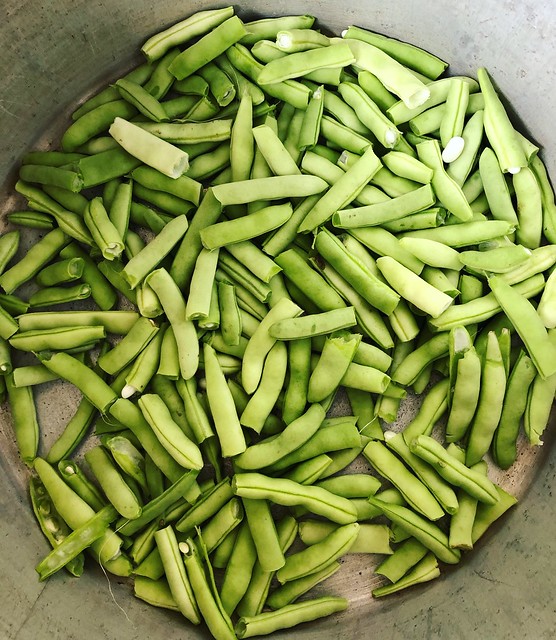Here is my latest column for the Charleston Gazette-Mail on green beans:
Green beans have a special place in Appalachia’s heart — no matter their form: half-runners or pole beans, leather britches or shuck beans, or even green bean casserole.
This versatile bean has been grown in Appalachia for more than 1,000 years, according to “Saving Seeds, Preserving Taste: Heirloom Seed Savers in Appalachia” by Bill Best.
And West Virginia has several unique native heritage varieties of pole beans (meaning they grow tall and need a pole for support) and half-runner beans (which are halfway between a bush bean and a pole bean, so they don’t grow quite as tall), according to “Heritage Beans as a Commercial Crop for West Virginia for West Virginia Farms” by Lewis W. Jett.
Growing beans
Heritage beans are popular in home gardens across Appalachia and connect generations through seed saving. That not only helps with biodiversity on farms, but it’s also important health-wise: Heritage beans tend to be high in fiber, low in fat and high in protein.
“West Virginia consumers who demand these beans cannot find them in local grocery markets or in most restaurants,” according to Jett.
So, these beans aren’t something you can find just anywhere — even if we Appalachians have a taste for them. And continuing to preserve these varieties for the future is important to preserving a piece of our history.
Stringing beans
Like many others, I have fond childhood memories of stringing beans. I vividly remember sitting with my neighbor, who set me up on a chair and taught me to break off the tip of the green bean, pull the string down the one side. Repeat on the other end, then snap them in half and place them in a big bucket.
I recently relived this memory at the Capitol Market with their 10th Annual Bean Stringin’ Event where people came to purchase local green beans, string them and donate them to Manna Meal, which are used all year round to feed those in need.
This pastime is near and dear to my heart — as well as many Appalachians who recall sitting on the porch with grandma, filling up a bucket.
Drying beans
While some beans may be cooked low and slow with some salted pork, many others (oftentimes greasy beans) are preserved in their pods.
Shuck beans or leather britches refers to stringing beans with a needle and thread, then hanging them out to dry before storing them in jars or bags. Months later, these beans can be rehydrated and cooked, which creates a silky, tender texture.
Legend dictates that the beans look like leather britches that had gotten wet and then dried out — hence the name. Shuck beans refers to the fact that they were dried in their shuck.
The bean’s legacy runs deep in Appalachia. Like many traditional foods, these beans were diverse, and Appalachians devised a way to make the summer bounty last throughout the winter. And through seed-savers, these heirloom beans are living on for future generations to enjoy as much as we do.
Green beans have a special place in Appalachia’s heart — no matter their form: half-runners or pole beans, leather britches or shuck beans, or even green bean casserole.
This versatile bean has been grown in Appalachia for more than 1,000 years, according to “Saving Seeds, Preserving Taste: Heirloom Seed Savers in Appalachia” by Bill Best.
And West Virginia has several unique native heritage varieties of pole beans (meaning they grow tall and need a pole for support) and half-runner beans (which are halfway between a bush bean and a pole bean, so they don’t grow quite as tall), according to “Heritage Beans as a Commercial Crop for West Virginia for West Virginia Farms” by Lewis W. Jett.
Growing beans
Heritage beans are popular in home gardens across Appalachia and connect generations through seed saving. That not only helps with biodiversity on farms, but it’s also important health-wise: Heritage beans tend to be high in fiber, low in fat and high in protein.
“West Virginia consumers who demand these beans cannot find them in local grocery markets or in most restaurants,” according to Jett.
So, these beans aren’t something you can find just anywhere — even if we Appalachians have a taste for them. And continuing to preserve these varieties for the future is important to preserving a piece of our history.
Stringing beans
Like many others, I have fond childhood memories of stringing beans. I vividly remember sitting with my neighbor, who set me up on a chair and taught me to break off the tip of the green bean, pull the string down the one side. Repeat on the other end, then snap them in half and place them in a big bucket.
I recently relived this memory at the Capitol Market with their 10th Annual Bean Stringin’ Event where people came to purchase local green beans, string them and donate them to Manna Meal, which are used all year round to feed those in need.
This pastime is near and dear to my heart — as well as many Appalachians who recall sitting on the porch with grandma, filling up a bucket.
Drying beans
While some beans may be cooked low and slow with some salted pork, many others (oftentimes greasy beans) are preserved in their pods.
Shuck beans or leather britches refers to stringing beans with a needle and thread, then hanging them out to dry before storing them in jars or bags. Months later, these beans can be rehydrated and cooked, which creates a silky, tender texture.
Legend dictates that the beans look like leather britches that had gotten wet and then dried out — hence the name. Shuck beans refers to the fact that they were dried in their shuck.
The bean’s legacy runs deep in Appalachia. Like many traditional foods, these beans were diverse, and Appalachians devised a way to make the summer bounty last throughout the winter. And through seed-savers, these heirloom beans are living on for future generations to enjoy as much as we do.



0 comments